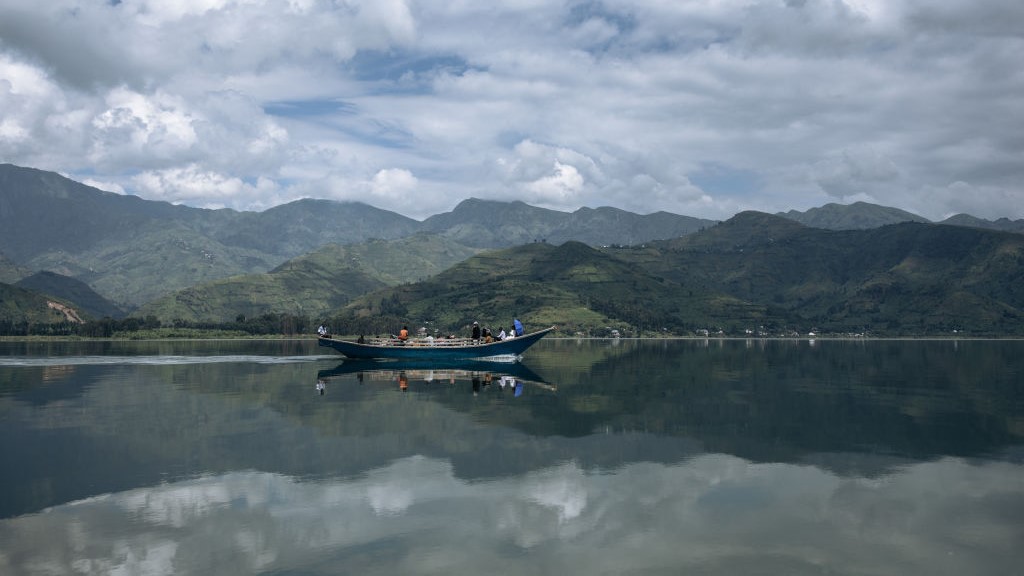
Name: Lake Kivu
Location: East-central Africa, straddling Rwanda and Congo
Coordinates: -1.914891119034228, 29.198902180922207
Why it's incredible: The lake contains huge amounts of explosive carbon dioxide and methane.
Lake Kivu is a giant body of water that is so saturated with carbon dioxide (CO2) and methane at its depths it could explode without warning. Two other lakes in Africa have a similarly deadly chemistry — lakes Nyos and Monoun in Cameroon — which have both exploded in the past 40 years, killing a total of nearly 1,800 people and thousands of animals.
Lake Kivu is one of the African Great Lakes that straddle a tectonic plate boundary called the East African Rift. In the rift, the Somalian tectonic plate is drifting eastward and away from the rest of the continent on the Nubian plate. (The Somalian plate is also known as the Somali plate, and the Nubian plate is also sometimes called the African plate.) This movement leads to volcanic and seismic activity in the region, which in turn funnels gases from deep inside Earth's crust to the surface — and into Lake Kivu's depths.
Related: Last Chance Lake: The unusual 'soda lake' with conditions that may have given rise to life on Earth
Lake Kivu is much bigger than either Lake Nyos or Lake Monoun, stretching 55 miles (90 kilometers) long, 30 miles (50 km) wide and up to 1,560 feet (475 meters) deep. The lake has an unusual, layered structure, with only the top 200 feet (60 m) of water mixing regularly and the lower layers remaining stagnant, Sergei Katsev, a professor of physical and geochemical limnology at the University of Minnesota Duluth, told National Geographic. This strict separation means that CO2 and methane bubbling up from the lakebed become trapped and accumulate in the bottom layer, 850 feet (260 m) deep and below, he said.
Roughly 72 cubic miles (300 cubic kilometers) of CO2 and 14 cubic miles (60 cubic km) of methane sit at the bottom of Lake Kivu, Katsev said, which is also laced with hydrogen sulfide gas from the depths of Earth's crust.
And this toxic cocktail could soon explode across the surrounding, densely populated region, Katsev said.
An explosion would release a huge cloud of gas that would hang over the lake for days to weeks and eventually dissipate into the atmosphere, Philip Morkel, an engineer and founder of Hydragas Energy, a company based in Canada that is planning to extract methane from Lake Kivu to produce electricity, told National Geographic. "When the lake reaches 100% saturation [in the bottom layer] — and it is currently somewhere over 60% — it will erupt spontaneously," Morkel said.

At that point, he said, the lake could release the equivalent of 5% of annual global greenhouse gas emissions in one day. The death toll from such an explosion would be staggering. Around 2 million people live on the shores of Lake Kivu, and "if anyone were in that cloud, it would take a minute to kill them," Morkel said.
While scientists can track how much gas is trapped in the lake, and thereby estimate the risk of an explosion, other, less predictable factors could also trigger a catastrophe. For example, an earthquake or sudden lava intrusion could shake up the lake's layers and cause an eruption, Katsev said.
The risk could also come from ongoing efforts to pump methane from the lake, Katsev said. Methane extraction began on the Rwandan side in 2016, with the goal of reducing the threat of an explosion while also supplying energy to power the country's electrical grid. But some experts warn that by disturbing the lake's structure, the operation could trigger the very explosion it is trying to prevent.
"It's a compromise of safety versus commercial exploitation in the long term," Katsev said. Extraction companies are pumping water from the bottom layer, removing methane, and returning the degassed water to the top layer. "The water generates a plume as it sinks downward," he said, heightening the risk of an explosion.







